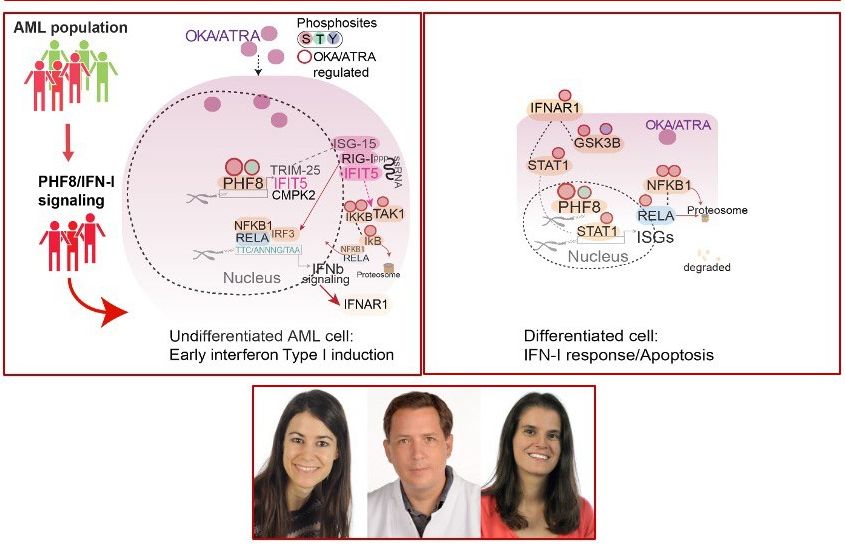News
Das "Paper of the Month" 10/2023 geht an: Anja Schmitt und Stephan Hailfinger aus der Medizinischen Klinik A
Für den Monat Oktober 2023 geht das „Paper of the Month“ der Medizinischen Fakultät der Universität Münster an:
Dr. Anja Schmitt und Prof. Dr. Stephan Hailfinger aus der Medizinischen Klinik A
BRD4 inhibition sensitizes diffuse large B-cell lymphoma cells to ferroptosis
Schmitt, A.; Grimm M., (…); Hailfinger, St.
SEP 2023 | BLOOD 142(13): 1155
Begründung der Auswahl:
In dem Paper geht es um eine gezielte Überwindung der Apoptose-Resistenz beim großzelligen diffusen B-Zell-Lymphom (DLBCL) durch Induktion von Ferroptose. In der Studie wurde ein Drugscreen durchgeführt und es konnten verschiedene Substanzen identifiziert werden, die durch epigenetische Mechanismen die Lymphomzellen für Ferroptose sensitivieren. Dies war mechanistisch auf eine Inhibition des epigenetischen Regulators BRD4 und die daraus resultierende verringerte Expression des ferroptosesupprimierenden Proteins 1 zurückzuführen. Zusammengefasst handelt es sich um eine translational relevante Studie zur gezielten Identifikation neuer therapeutischer Optionen zur Behandlung des aggressiven DLBCL.
Zu Hintergrund, Fragestellung und Bedeutung der Publikation:
Das diffuse großzellige B-Zell-Lymphom ist die häufigste Neoplasie des lymphatischen Systems im Erwachsenenalter. Die Standardtheraphie besteht aus einer Kombination von Chemotherapeutika und dem Antikörper Rituximab und zeigt bei circa zwei Dritteln der Patienten ein dauerhaftes Ansprechen. Bei den restlichen Patienten ist sie dagegen nicht oder nur vorübergehend wirksam. Diesem Therapieversagen liegt häufig eine Apoptose-Resistenz der Tumorzellen zugrunde.
In den letzten Jahren konnten mehrere Studien zeigen, dass diese therapieresistenten Tumorzellen besonders anfällig gegenüber einer anderen Form des programmierten Zelltods, der Ferroptose, sind. Die Ferroptose ist ein eisenabhängiger Zelltod, in dessen Zentrum eine massive Oxidation von Membranlipiden und letztlich der Verlust der Membranintegrität steht. DLBCL-Zellen sind sehr anfällig gegenüber einer pharmakologischen Ferroptose-Induktion, unter anderem aufgrund ihres niedrigen antioxidativen Potentials. Mithilfe einer Substanzbibliothek mit epigenetischen Modulatoren konnten wir BET-Inhibitoren als ferroptosesensitivierende Substanzen identifizieren. In den Lymphomzellen hemmen sie die Expression des Ferroptosis-Suppressor-Proteins 1 und erhöhen somit die Ferroptose-Suszeptibilität.
Die gezielte Kombination von BET-Inhibitoren mit Substanzen, die Ferroptose auslösen können, war in präklinischen Lymphom-Modellen sehr wirkungsvoll und könnte eine vielversprechende Ergänzung zur Standardtherapie darstellen beziehungsweise sich bei apoptoseresistenten Tumoren als Behandlungsalternative erweisen.
Background and fundamental question of the publication:
Diffuse large B-cell lymphoma (DLBCL) represents the most frequent cancer of the lymphatic system in adults. While the standard multiagent chemotherapy supplemented with the anti-CD20 antibody Rituximab cures approx. 2/3 of DLBCL patients, the residual patients either do not respond to this treatment or relapse after an initial response. Failure of the standard therapy is often caused by apoptosis resistance of the tumor cells.
In the past years, several studies have demonstrated that these therapy-resistant tumor cells are particularly susceptible to another type of programmed cell death, i.e. to ferroptosis. Ferroptosis is an iron-dependent cell death that involves excessive oxidation of membrane lipids and the loss of membrane integrity. It has been shown that DLBCL cells are particularly sensitive towards ferroptosis induction, partially due to their low anti-oxidative potential. To identify drugs that sensitize DLBCL cells towards ferroptosis, we have screened a compound library containing epigenetic modulators. With this approach, we could demonstrate that BET inhibitors suppress the expression of the ferroptosis suppressor protein 1 and thus increase the ferroptosis susceptibility of the DLBCL cells.
Combination treatment with BET inhibitors and ferroptosis inducers exhibited a profound anti-lymphoma effect in preclinical DLBCL models. This provides a rationale to further evaluate the potential of ferroptosis-inducers/-sensitizers to supplement standard immunochemotherapy or as an alternative treatment strategy for apoptosis-resistant tumors.
Die bisherigen ausgezeichneten „Papers of the Month“ finden Sie HIER.




